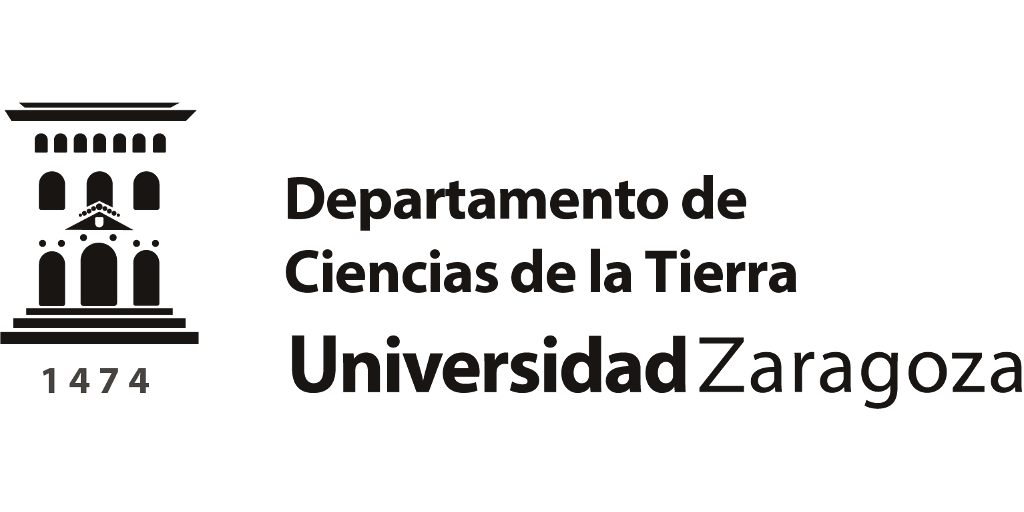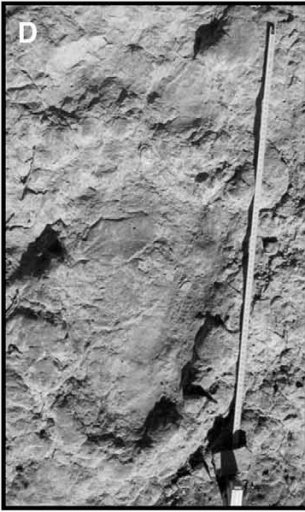El trabajo liderado por nuestro colega Alberto Cobos describe en detalle este rastro. Son icnitas de gran tamaño y que presentan una morfología interpretada como de estegosaurios. Es un rastro de un típico dinosaurio cuadrúpedo, con impresiones del pie y por delante la mano (más pequeña). El pie es alargado y con la impresión de tres dedos dirigidos hacia adelante. La mano tiene forma arriñonada y sin marcas aparentes de los dedos.
En los últimos años se están haciendo grandes avances en las icnitas de estegosaurios. Los restos fósiles de estos dinosaurios son abundantes en el Jurásico Superior, sin embargo sus icnitas eran prácticamente desconocidas. La respuesta hay que buscarla en que en muchos casos se interpretaban las icnitas cuadrúpedas del Jurásico Superior como de saurópodos. Sin embargo icnitas como Dacentrurus ibericus no pueden ser de saurópodo al presentar la impresión de solo tres dedos en el pie, y además estar dirigidos hacia adelante. Esta distribución del pie es más tipica de los estegosaurios.
La referencia completa es: Cobos, A., Royo-Torres, R., Luque, L., Alcalá, L., Mampel, L. 2010. An iberian stegosaurs paradise: The Villar del Arzobispo Formation (Tithonian-Berriasian) in Teruel (Spain). Palaeogeography, Palaeoclimatology, Palaeoecology, 293, 223-236.
Os adjuntamos el resumen
Since 2002 a number of sites containing stegosaurian remains (bones and tracks) have been discovered in the Villar del Arzobispo Formation (Tithonian–Berriasian) in the Province of Teruel, Spain, mostly in the areas of El Castellar and Riodeva. The material from the latter consists of the postcranial remains of the axial, pelvic and appendicular skeleton of several different sized specimens related to the genus Dacentrurus. The footprints made by a stegosaurian at El Castellar site reflect a new type of medium gauge trackway: Deltapodus ibericus isp. nov. The presence of these tracks near abundant bones related to Dacentrurus highlights this geological formation as a window through which to examine the systematics, behaviour and palaeoecology of these thyreophoran dinosaurs. Since these fossil bones were discovered next to those of other sauropods and ornithopods (Turiasaurus and Ornithopoda indet.) where there has been virtually no transport of the remains, and since stegosaurian tracks have been found in ichnoassociations with the same groups, they may have coexisted in the wetlands of restricted tidal environments during the Tithonian– Berriasian. The presence of common (or at least phylogenetically closely related) taxa and ichnotaxa in Western Europe, North America and Africa indicates that sea-level fall episodes may have occurred during which the fauna of each area may have reached the emerged regions of the others during the Late Jurassic.
En los últimos años se están haciendo grandes avances en las icnitas de estegosaurios. Los restos fósiles de estos dinosaurios son abundantes en el Jurásico Superior, sin embargo sus icnitas eran prácticamente desconocidas. La respuesta hay que buscarla en que en muchos casos se interpretaban las icnitas cuadrúpedas del Jurásico Superior como de saurópodos. Sin embargo icnitas como Dacentrurus ibericus no pueden ser de saurópodo al presentar la impresión de solo tres dedos en el pie, y además estar dirigidos hacia adelante. Esta distribución del pie es más tipica de los estegosaurios.
La referencia completa es: Cobos, A., Royo-Torres, R., Luque, L., Alcalá, L., Mampel, L. 2010. An iberian stegosaurs paradise: The Villar del Arzobispo Formation (Tithonian-Berriasian) in Teruel (Spain). Palaeogeography, Palaeoclimatology, Palaeoecology, 293, 223-236.
Os adjuntamos el resumen
Since 2002 a number of sites containing stegosaurian remains (bones and tracks) have been discovered in the Villar del Arzobispo Formation (Tithonian–Berriasian) in the Province of Teruel, Spain, mostly in the areas of El Castellar and Riodeva. The material from the latter consists of the postcranial remains of the axial, pelvic and appendicular skeleton of several different sized specimens related to the genus Dacentrurus. The footprints made by a stegosaurian at El Castellar site reflect a new type of medium gauge trackway: Deltapodus ibericus isp. nov. The presence of these tracks near abundant bones related to Dacentrurus highlights this geological formation as a window through which to examine the systematics, behaviour and palaeoecology of these thyreophoran dinosaurs. Since these fossil bones were discovered next to those of other sauropods and ornithopods (Turiasaurus and Ornithopoda indet.) where there has been virtually no transport of the remains, and since stegosaurian tracks have been found in ichnoassociations with the same groups, they may have coexisted in the wetlands of restricted tidal environments during the Tithonian– Berriasian. The presence of common (or at least phylogenetically closely related) taxa and ichnotaxa in Western Europe, North America and Africa indicates that sea-level fall episodes may have occurred during which the fauna of each area may have reached the emerged regions of the others during the Late Jurassic.
LUGAR El Castellar, Teruel, España



















